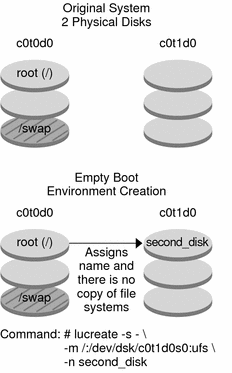 To Create an Empty Boot Environment for a Solaris Flash Archive
(Command-Line Interface)
To Create an Empty Boot Environment for a Solaris Flash Archive
(Command-Line Interface)
The lucreate command creates a boot environment that is based on the file systems in the active boot environment. When using the lucreate command with the -s - option, lucreate quickly creates an empty boot environment. The slices are reserved for the file systems that are specified, but no file systems are copied. The boot environment is named, but not actually created until installed with a Solaris Flash archive. When the empty boot environment is installed with an archive, file systems are installed on the reserved slices.
-
Become superuser or assume an equivalent role.
Roles contain authorizations and privileged commands. For more information about roles, see Configuring RBAC (Task Map) in System Administration Guide: Security Services.
-
Create the empty boot environment.
# lucreate -A 'BE_name' -s - \ -m mountpoint:device[,metadevice]:fs_options -n BE_name
- -A 'BE_description'
-
(Optional) Enables the creation of a boot environment description that is associated with the boot environment name (BE_name). The description can be any length and can contain any characters.
- -s -
-
Specifies that an empty boot environment be created.
- -m mountpoint:device[,metadevice]:fs_options [-m...]
-
Specifies the file systems' configuration of the new boot environment. The file systems that are specified as arguments to -m can be on the same disk or they can be spread across multiple disks. Use this option as many times as needed to create the number of file systems that are needed.
-
mountpoint can be any valid mount point or – (hyphen), indicating a swap partition.
-
device field can be one of the following:
-
The name of a disk device, of the form /dev/dsk/cwtxdysz
-
The name of a Solaris Volume Manager metadevice, of the form /dev/md/dsk/dnum
-
The name of a Veritas Volume Manager volume, of the form /dev/vx/dsk/volume_name
-
The keyword merged, indicating that the file system at the specified mount point is to be merged with its parent
-
-
fs_options field can be one of the following:
-
ufs, which indicates a UFS file system.
-
vxfs, which indicates a Veritas file system.
-
swap, which indicates a swap file system. The swap mount point must be a – (hyphen).
-
For file systems that are logical devices (mirrors), several keywords specify actions to be applied to the file systems. These keywords can create a logical device, change the configuration of a logical device, or delete a logical device. For a description of these keywords, see To Create a Boot Environment With RAID-1 Volumes (Mirrors) (Command-Line Interface).
-
-
- -n BE_name
-
The name of the boot environment to be created. BE_name must be unique on the system.
Example 4–8 Creating an Empty Boot Environment for a Solaris Flash Archive (Command-Line Interface)
In this example, a boot environment is created but contains no file systems. A description, mydescription, is associated with the new boot environment that is named second_disk.
# lucreate -A 'mydescription' -s - \ -m /:/dev/dsk/c0t1d0s0:ufs -n second_disk |
When creation of the empty boot environment is complete, a flash archive can be installed and can be activated (made bootable). See Chapter 5, Upgrading With Solaris Live Upgrade (Tasks).
For an example of creating and populating an empty boot environment, see Example of Creating an Empty Boot Environment and Installing a Solaris Flash Archive (Command-Line Interface).
The following image shows the creation of an empty boot environment.

- © 2010, Oracle Corporation and/or its affiliates
